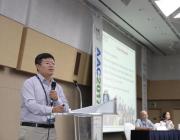摘要:
In order to characterize the features of particulate pollution in the Pearl River Delta (PRD) in the summer, continuous measurements of particle number size distributions and chemical compositions were simultaneously performed at Guangzhou urban site (GZ) and Back-garden downwind regional site (BG) in July 2006. Particle number concentration from 20 nm to 10 mu m at BG was (1.7 +/- 0.8) x 10(4) cm(-3), about 40% lower than that at GZ, (2.9 +/- 1.1) x 10(4) cm(-3). The total particle volume concentration at BG was 94 +/- 34 mu m(3) cm(-3), similar to that at GZ, 96 +/- 43 mu m(3) cm(-3). More 20-100 nm particles, significantly affected by the traffic emissions, were observed at GZ, while 100-660 nm particle number concentrations were similar at both sites as they are more regional. PM(2.5) values were similar at GZ (69 +/- 43 mu g m(-3)) and BG (69 +/- 58 mu g m(-3)) with R(2) of 0.71 for the daily average PM(2.5) at these two sites, indicating the fine particulate pollution in the PRD region to be regional. Two kinds of pollution episodes, the accumulation pollution episode and the regional transport pollution episode, were observed. Fine particles over 100 nm dominated both number and volume concentrations of total particles during the late periods of these pollution episodes. Accumulation and secondary transformation are the main reasons for the nighttime accumulation pollution episode. SO(4)(2-), NO(3)(-), and NH(4)(+) accounted for about 60% in 100-660 nm particle mass and PM(2.5) increase. When south or southeast wind prevailed in the PRD region, regional transport of pollutants took place. Regional transport contributed about 30% to fine particulate pollution at BG during a regional transport case. Secondary transformation played an important role during regional transport, causing higher increase rates of secondary ions in PM(1.0) than other species and shifting the peaks of sulfate and ammonium mass size distributions to larger sizes. SO(4)(2-), NO(3)(-), and NH(4)(+) accounted for about 70% and 40% of PM(1.0) and PM(2.5), respectively.附注:
ISI Document Delivery No.: 665WGTimes Cited: 27Cited Reference Count: 31Yue, D. L. Hu, M. Wu, Z. J. Guo, S. Wen, M. T. Nowak, A. Wehner, B. Wiedensohler, A. Takegawa, N. Kondo, Y. Wang, X. S. Li, Y. P. Zeng, L. M. Zhang, Y. H.Guo, Song/D-9218-2012; Wiedensohler, Alfred/D-1223-2013; Zhang, Yuanhang/F-7038-2011; Wehner, Birgit/C-2650-2014; Nowak, Andreas/B-6413-2014; Wu, Zhijun/A-7041-2012; Kondo, Yutaka/D-1459-2012; Zeng, Limin/D-3948-2013Guo, Song/0000-0002-9661-2313;National High-tech R&D Program (863 Program) [2006AA06A308]; Ministry of Science & Technology, China P. R. China [2002CB211605, 2002CB410801]This research was supported by the National High-tech R&D Program (863 Program, 2006AA06A308) and the National Basic Research Program (2002CB211605, 2002CB410801) from Ministry of Science & Technology, China P. R. China. The author would also like to thank Fan Yang, Rui Xiao, Weiwei Hu, Jianwei Gu, and Hang Su for supplying important data for this paper.35547Copernicus gesellschaft mbhGottingen